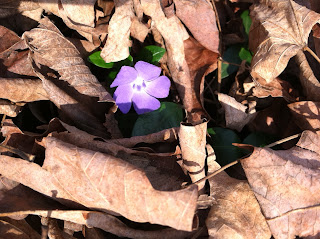Last year, I wrote a post about Swiss chard, a leafy green vegetable that I never ate growing up... heck, I never even heard of Swiss chard until I was out of high school.
Brussels sprouts were another matter. I had heard of Brussels sprouts throughout my childhood. In children's books, movies and other incursions of pop culture, Brussels sprouts are often reviled and forcing children to eat them has been seen a cruel sort of punishment inflicted by their misanthropic parents. However, because my mom doesn't like Brussels sprouts, it meant that I never had to eat them as a kid. Phew - I was spared.
However, in the past few years, I have come to appreciate this wackiest member of the cabbage family. Brussels sprouts grow as little cabbages at the base of big cabbage-y leaves on a stout green stalk, which makes them visually arresting. They are also incredibly cold hardy - even our 12 inches of snow in October didn't phase them. Cold weather reportedly improves the sweetness of the sprouts, although I have not rigorously tested this hypothesis - I will pass on harvesting sprouts early to see if they are more bitter, I'll just wait.
 |
| Looks a bit like Christmas, eh? |
Cooked properly, they lose any bitterness and sour cabbage flavor - and are instead a rich, crunchy green vegetable in a season where green seems a distant memory. I emphasize
cooked properly - you want to make sure that the centers of the sprouts are fully cooked, otherwise you will have the full experience of bitter, sour cabbage. I would hazard a guess that poorly cooked Brussels sprouts over the years have contributed to their bad reputation in pop culture and conventional wisdom. Also, we've found that Brussels sprouts are something to enjoy in season (late fall and early winter) when their flavor is best - we have had bad luck with grocery store sprouts in late winter.
Here's Adam's favorite way to prepare Brussels sprouts and my favorite way to eat them - and this takes 15 minutes start to finish.
Pan-Roasted Brussels Sprouts
Heat a large saute pan or skillet with 2 tablespoons of butter or olive oil.
Add 1 pound Brussels sprouts, cleaned, rinsed and cut in half (or quarters, if they are very large).
Cook the sprouts over medium-high heat, stirring/tossing occasionally, for 10 minutes, or until you can easily poke a fork into the center of a sprout. The outer leaves and edges of the sprouts should be nicely browned and delightfully crispy.
For another test of doneness, try to squash one sprout piece with the back of a fork - if it yields with moderate pressure (i.e. doesn't collapse instantly and isn't a brick wall), you're on the right track.
Season with salt, pepper and a squeeze of lemon.
 |
| Raw sprouts ready for their hot butter bath |
You could also cook these in the oven, but it takes longer and you can't fuss over it in the same way that you can with stovetop cooking. If you're into no-fuss and have the time, heat your oven to 400 degrees, toss the sprouts with olive oil and salt and pepper, dump them onto a cookie sheet, and bake for 40 minutes until the edges are crisp and the insides are creamy.
I will say that the kitchen can retain a certain cabbage-y odor after cooking Brussels sprouts, so I would recommend washing the pan as soon as possible and using the range hood over your stove top, if you've got one.


